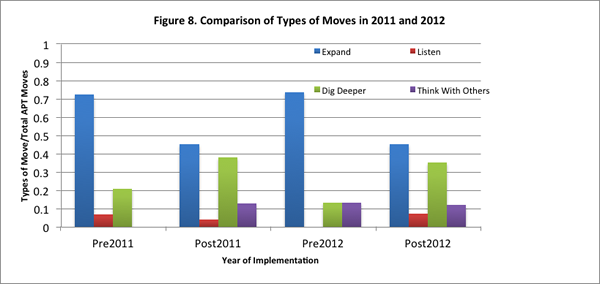Grade 4 Science Discussions 2011-2012
Introduction
In the third year of our research (2011-2012), we collected audio recordings of concept cartoon discussions from eight Grade 4 teachers. Recordings of pre- discussions were gathered from eight teachers and recordings of post-discussions from six teachers. Of the eight teachers, four teachers — Evan, Hein, Wolf, and Smith — had participated in the Talk Science research in the previous year in 2010-2011 (teacher names appearing in the report are pseudonyms).
As part of the Talk Science professional development, teachers were introduced to a set of academically productive talk moves (APT moves). The APT moves were designed to promote students’ scientific reasoning and co-construction of scientific understandings with peers. The purpose of this analysis was to study teachers’ use of the APT moves to facilitate classroom discussions; students’ engagement in the discussions; and with a subset of teachers who were now participating in the Talk Science program for the second time, we wanted to also compare teachers’ practice over the two years of their experience with the talk moves to support discussions.
Coding Scheme and Procedure
Similar to the coding scheme and procedure followed in the analysis of Grade 4 teachers’ facilitation in 2010-2011 (see section on Grade 4 Science Discussions 2010-2011), we coded and counted teachers’ turns at talk to examine their use of academically productive talk moves (APT moves). The coding scheme for teachers’ talk was as follows:
Teachers’ Facilitation of Science Discussions:
- Expand Moves (Say More; Revoice; Time to Think): This set of moves was designed to encourage individual students to elaborate on their ideas (e.g., “The bigger the size the more space it takes up and then the more volume it has. Is that what you’re saying — is that what you are — and so?”).
- Listen Moves (Who can Restate/Repeat): This set of moves was designed to encourage individual students to elaborate on their ideas (e.g., “Can someone repeat what Avery said in their own words?”).
- Dig Deeper Moves (Press for Reasoning/Why; Challenge): This set of moves was designed to prompt students to push their understanding by digging deeper into their reasoning and providing evidence for their ideas (e.g., “Why do you think it’s important to have the same type of container and the same size of container? Why do you think that’s important?”).
- Think With Others (Add On; Who Can Explain; Do you Agree/Disagree): This set of moves engaged students to think with and respond to their peers’ ideas in fostering co-construction of their understanding (e.g., “No way to know for sure. Okay. Okay. Anyone want to add anything to that or disagree with that or anything?”).
We also coded and counted students’ turns at talk to identify the extent to which they attempted to co-construct science understandings with their peers, and to make sense of the science. The co-construction attempts consisted of the following:
Students’ Co-construction:
- Agree (e.g., “I agree with Bianca and Shereen...”)
- Disagree (e.g., “No. But I disagree with what Daniel said with the salt being hot.”)
- Ask for Clarification (e.g., “What do you mean when you say?”)
- Clarify Others’ Idea (e.g., “I think what Shereen is trying to say...”)
- Challenge (e.g., “I have a question for you. What if the eraser had like buoyancy?”)
- Restate Other (e.g., “She said there’s more space in the air particles.”)
- Add-On (e.g., “I also wanted to add on to Louie’s...”)
Students’ Scientific Sense-Making:
Students’ attempts to make sense of the science consisted of the following:
- Revise (students provide evidence of revised thinking, e.g., “Actually, I kind of changed my idea now...”)
- Raise a related question (e.g., “I have a question. Where does the water go when it evaporates?”)
- Propose Test (Propose solution to determine volume of the candles, e.g., “You could put them in water and see the water level rise”). In the analysis, this code is also used to identify the extent to which students applied ideas from the curriculum in proposing tests to evaluate the conflicting claims presented in the concept cartoon.
The analysis found that teachers utilized various APT moves in facilitating classroom discourse, and generally used moves more often in the post-discussions. Further, teachers attempted to develop certain aspects of their practice, which is seen in the greater use of two sets of talk moves in the post-discussions - Dig Deeper and Listen moves — whereas these moves were either non-existent or used rarely in the pre-discussions.
Moreover, with the four teachers who were participating in the Talk Science program for the second time, the analysis showed they had used more often Dig Deeper and Think With Others talk moves in post-discussions than pre-discussions in their first year, and continued using these moves in the pre-discussions of their second year. For facilitating post-discussions in their second year, the teachers also drew on Listen moves and increased their use of Dig Deeper moves substantially. Further, three of the four teachers increased their use of APT moves in the second year, and they made the greatest use of talk moves in the post-discussion at the end of the second year.
With respect to students’ participation, the findings revealed that students made several attempts at engaging with and contributing to the discussion. They generated ideas and proposed tests for evaluating competing claims in the concept cartoon more often in the post-discussions than in the pre-discussions. Further, in proposing tests to evaluate the claims, students drew more on the formal science ideas they learned in the curriculum than on ideas from outside the curriculum. The findings suggest that students attempted to apply their understanding of the formal science ideas from the curriculum to the concept cartoon problem.
Here we elaborate on various findings from our analysis of the Grade 4 pre- and post-concept cartoon discussions from 2011-2012. Please refer to the NSF report for more details.
Classroom Discourse Findings
Our analysis showed some kinds of talk moves were already part of the teachers’ practice, as seen in their use of talk moves in guiding pre-discussions (see Figure 1). Further, five of the six teachers from whom we have pre-post data used more academically productive talk moves (APT moves) in the post- discussions than in the pre- discussions. (see Figure 1). There was also considerable variation in teachers’ use of talk moves to orchestrate classroom talk in pre-and post-discussions.
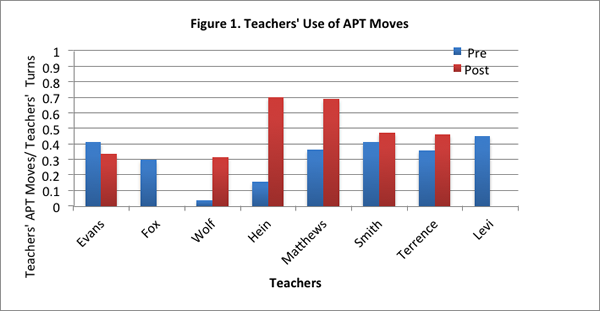
A closer examination of teachers’ use of APT moves revealed that the greatest increase in the use of moves across the six teachers (pre-post data) occurred with respect to the Dig Deeper Moves (Press for Reasoning/Why; Challenge moves). For example, “Why do you think it’s important to have the same type of container and the same size of container? Why do you think that’s important?” (see Figure 2; the data are calculated as proportion of different types of APT moves used from the total number of APT moves used by the teachers). Figure 2 shows that approximately 8% of the total APT moves used involved Dig Deeper moves in the pre discussions, whereas approximately 32% of the total APT moves used in the post-discussions were Dig Deeper moves.
Further, in the pre-discussions, the teachers did not use any listening moves, whereas the listening moves accounted for 7.77% of all APT moves used in the post-discussions. For example, “Can someone repeat what Avery said in their own words? [9 second pause] Grace, give it a try.”
On the contrary, there was a remarkable decrease in teachers’ use of Think With Others moves, which accounted for 12.62% of APT moves used in the post-discussions, as opposed to 35.44% of the APT moves used in the pre-discussions.
(Add On; Who can Explain; Do you Agree/Disagree). For example, “No way to know for sure. Okay. Okay. Anyone want to add anything to that or disagree with that or anything?”)
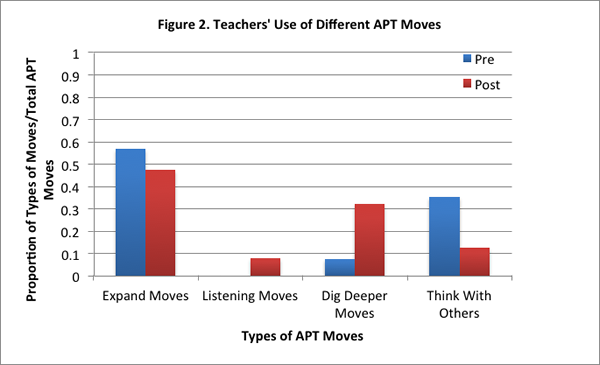
Our analysis of students’ talk indicated that they made attempts at co-constructing ideas with their peers in the pre-discussions (see Figure 3). Of the six teachers’ classes, students in two classes made more co-construction attempts in the post-discussions.
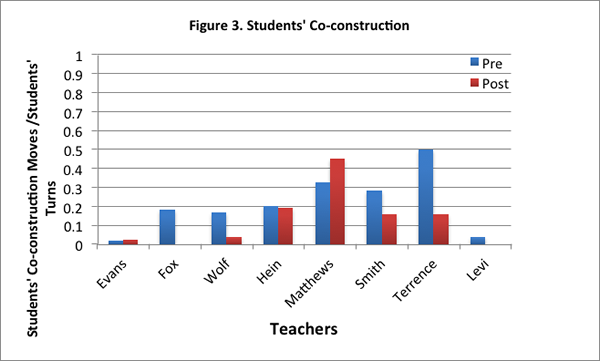
Further, students made more sense-making attempts in their turns at talk in the post-discussions than in the pre-discussions (see Figure 4). This pattern was observed in all six classes where we have both pre- and post-discussion data.
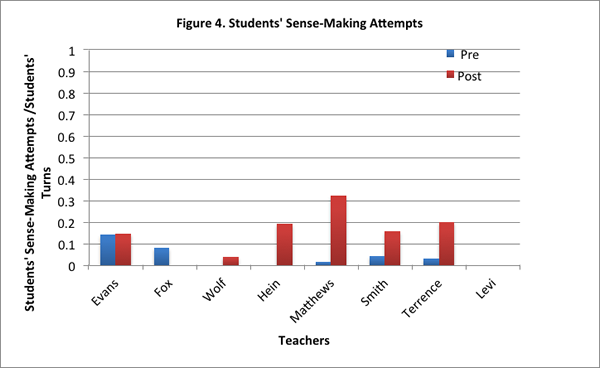
Upon a closer examination of students’ sense-making attempts in the post-discussions, we found that sense-making involved mainly proposing ideas for testing the competing claims presented in the concept cartoon. There were few instances of students generating new questions related to the science content, and revising their thinking in light of the discussion and their experiences. Figure 5 shows the proportion of students’ sense-making attempts involving proposing tests to determine the volume of the candles.
The elicitation of students’ ideas for testing the claims was part of the recommended question for this concept cartoon. More of students’ talk in the post-discussion than the pre-discussion involved proposing ideas to evaluate the competing claims. Whereas this is a positive finding that students generated ideas for testing claims more often in the post than in the pre discussions, an additional analysis of the extent to which the teachers prompted students to propose ideas for evaluating claims in the pre- and post-discussions may shed light on this finding. It is possible that teachers encouraged students to propose tests more often in the post-discussions than pre discussions. A preliminary examination suggests that in the pre-discussions, two of the teachers prompted students explicitly to discuss ways to test the concept cartoon ideas. In the post-discussions, on the other hand, all six teachers encouraged students explicitly to propose experiments to test the ideas. A further study of the discussions is needed to clarify the trend observed in students’ use of scientific moves.
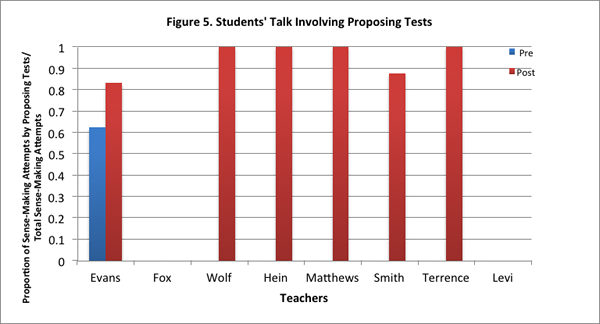
With respect to students’ turns involving proposing tests to determine the volume of candles, we examined also the extent to which the turns contained ideas based on the curriculum (see Figure 6). Figure 6 shows the proportion of turns involving ideas from the curriculum out of the total turns that presented tests to determine the volume of the candles. Specifically, the analysis identified the extent to which students applied ideas from the curriculum, such as water displacement, measuring the volume of liquids (liquid wax), using centimeter cubes for estimation, and measuring the weight in proposing tests to assess the competing claims presented in the concept cartoon. Ideas from outside the curriculum included using a mathematical formula to calculate volume of candles; reshaping the candles to make them comparable; determining the time taken to melt/burn the candle, etc.
Figure 6 indicates that in five of the six teachers’ classes, more than half of students’ proposed tests in the post-discussions contained ideas based on the curriculum than from outside the curriculum. This finding indicates that students tried to apply their understanding of the science from the curriculum while discussing the concept cartoon.
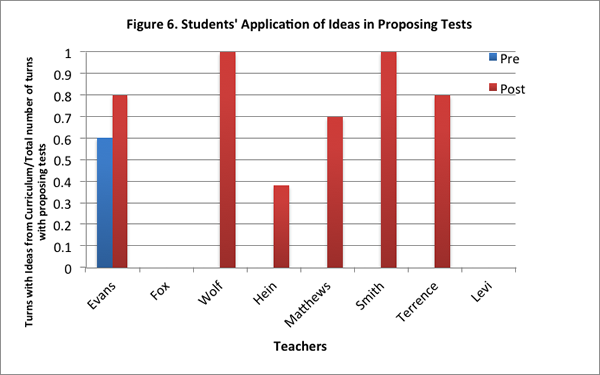
Looking across all the findings, the decrease in teachers’ use of the Think With Others moves and the general decrease in students’ co-construction moves are patterns that need to be examined further. The Think With Others moves were designed to facilitate students’ engagement with their peers’ ideas. One would expect that in the case of a judicious, strategic use of talk moves by a teacher, there would be less explicit prompting and support provided to the students to engage in particular discourse practices as the students begin to appropriate and display increasing fluency in the practices. The present analysis shows, however, that whereas teachers made less use of Think With Others moves, the students did not increase their attempts at co-construction. This finding points to the need to examine further the relationship between teachers’ use of talk moves and students’ participation in the discourse.
Comparative Analysis of Findings from 2010-2011 & 2011-2012
It should be noted that the concept cartoons used for pre- and post-discussions in 2011-2012 were different from those used in 2010-2011. Furthermore, the coding rubric for students’ talk underwent some changes between the two years. These differences notwithstanding, certain comparisons were drawn for four teachers — Evans, Smith, Hein, and Wolf — who participated two times in the Talk Science program, and have pre and post discussion data for both years. The comparative analysis between 2010-2011 and 2011-2012 revealed the following patterns:
During both years, teachers used more talk moves in the post-discussions than the pre-discussions (see Figure 7). The APT moves accounted for 18.47% of teachers’ turns in pre-discussions in 2011; 31.56% in post-discussions in 2011; 30.16% in pre-discussions in 2012; and 42.93% in post-discussions in 2012.
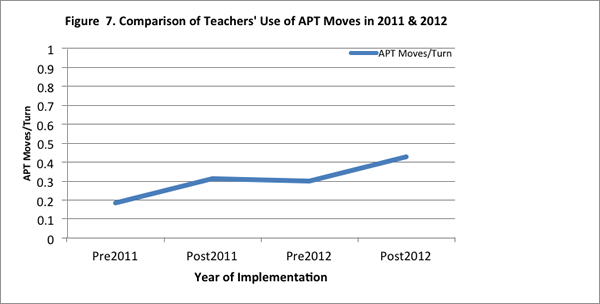
We analyzed further the four teachers’ use of the various APT Moves (4 categories of moves: Expand; Listen; Dig Deeper; Think with Others). See Figure 8. Figure 8 shows that when considering the total number of APT moves used by the four teachers, in 2011, the teachers (when examined together) predominantly used the Expand moves in the pre-discussions (72.41% of all the APT moves in pre2011). There was less use of Dig Deeper moves, an even lesser use of the Listen moves (6.9%), and no use of the Think with Others moves in the pre-discussions in 2011. In post 2011 discussions, whereas the teachers continued to show a fair amount of use of the Expand moves (45.07%), they showed a marked increase in their use of the Dig Deeper moves (about 38%). They also incorporated the Think with Others moves in the post-discussions in 2011 (12.68%). These are positive findings indicating that teachers were able to draw on these two sets of moves through participation in the Talk Science program. But they continued to make less use of the Listen moves in the post-discussions in 2011 (4.23%).
In 2012, similar to their facilitation in the previous year, the four teachers (when examined together) continued to use the Expand moves in the pre- and post- discussions to a large extent (73.68% in pre2012; 45.12% in post 2012). Similar to 2011, the four teachers started their facilitation in 2012 with less use of the Dig Deeper moves (13.16% of their APT moves in pre 2012), but showed marked increase in the use of this type of moves in the post-discussions (35.37%).
With respect to the use of Think with Others moves, we found that in 2012, teachers started by making some use of this set of moves they had learnt through the Talk Science program from the previous year (13.16% of the APT moves in pre 2012 discussions). This is an encouraging finding because in pre 2011 discussions, teachers had not made any use of these moves. Their initial use of these moves in 2012 was almost as much as where they had ended in 2011 (13.16% in pre 2012; 12.68% in post 2011), suggesting that teachers had retained this set of moves in their practice. However, there was not much increase in the use of these moves in post 2012.
Finally, with respect to the use of Listen moves, we found that similar to their facilitation in 2011, the four teachers (when examined together) continued to make less use of the Listen moves in 2012. They did not use any Listen moves in pre 2012 discussions, but made some use of this move in the post 2012 discussions (7.32% of the APT moves).
Overall, the comparative analysis indicated that teachers were able to incorporate various talk moves into their practice, particularly the Dig Deeper moves, for guiding science discussions. Furthermore, although they made some use of the Think with Others and Listen moves, in general, teachers tended to focus less on these two sets of talk moves.
